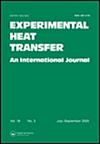Experimental investigation of effect of iron oxide nanofluids with different morphology on heat transfer of multiple impinging jets
IF 2.9
3区 工程技术
Q2 ENGINEERING, MECHANICAL
引用次数: 2
Abstract
ABSTRACT This research aims to experimentally investigate the thermal performance of iron oxide nanofluids having different particle shapes for multiple impinging jet flow. The heat transfer performance of nanofluids with spherical like, faced nanocube and nanowires shapes prepared by hydrothermal synthesis was investigated experimentally. The weight percentage of the nanofluids examined in this study is 0.2 wt%, and different jet-to-jet spacing (B) and jet-to-plate distance (H) values were tested for each nanofluid. The experiments were carried out for laminar flow conditions, the temperature distribution was obtained through thermocouples, and the Nu number was calculated for each case. In experiments using nanowires, it was observed that the highest Nu numbers were obtained for jet-target/diameter ratio 2 for all cases (jet spaces and Reynolds numbers). Maximum Nu number enhancement was approximately 27.3% compared to pure water for the specified conditions. This value is quite significant since it was obtained with a relatively low concentration of nanofluids. It was observed that the particle size and morphology shape significantly impact nanofluids’ performance in heat transfer.不同形态氧化铁纳米流体对多重撞击射流传热影响的实验研究
摘要本研究旨在通过实验研究不同颗粒形状的氧化铁纳米流体在多重撞击射流中的热性能。实验研究了水热合成法制备的球形、面状纳米立方体和纳米线纳米流体的传热性能。本研究中检测的纳米流体的重量百分比为0.2 并且对每种纳米流体测试不同的射流-射流间距(B)和射流-板距离(H)值。在层流条件下进行实验,通过热电偶获得温度分布,并计算每种情况下的Nu数。在使用纳米线的实验中,观察到在所有情况下(射流空间和雷诺数),射流靶/直径比2获得了最高的Nu数。在特定条件下,与纯水相比,最大Nu值增加约27.3%。这个值非常显著,因为它是用相对低浓度的纳米流体获得的。研究发现,颗粒大小和形态形状对纳米流体的传热性能有显著影响。
本文章由计算机程序翻译,如有差异,请以英文原文为准。
求助全文
约1分钟内获得全文
求助全文
来源期刊

Experimental Heat Transfer
工程技术-工程:机械
CiteScore
6.30
自引率
37.10%
发文量
61
审稿时长
>12 weeks
期刊介绍:
Experimental Heat Transfer provides a forum for experimentally based high quality research articles and communications in the general area of heat-mass transfer and the related energy fields.
In addition to the established multifaceted areas of heat transfer and the associated thermal energy conversion, transport, and storage, the journal also communicates contributions from new and emerging areas of research such as micro- and nanoscale science and technology, life sciences and biomedical engineering, manufacturing processes, materials science, and engineering. Heat transfer plays an important role in all of these areas, particularly in the form of innovative experiments and systems for direct measurements and analysis, as well as to verify or complement theoretical models.
All submitted manuscripts are subject to initial appraisal by the Editor, and, if found suitable for further consideration, to peer review by independent, anonymous expert referees. All peer reviews are single blind and submission is online via ScholarOne Manuscripts. Original, normal size articles, as well as technical notes are considered. Review articles require previous communication and approval by the Editor before submission for further consideration.
 求助内容:
求助内容: 应助结果提醒方式:
应助结果提醒方式:


